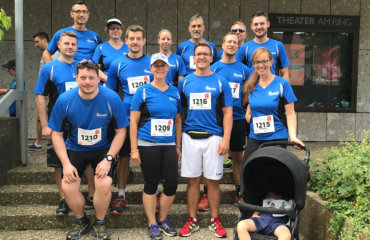
A few people are standing in front of a large whiteboard in the meeting room. The sales department, two OKR Masters and a member of the management board, look at colorful index cards on which objectives are noted. Individual objectives are explained while the colleagues from Sales listen intently. Then the discussion starts: what contribution can the team do to achieving the objectives presented? These contributions are then recorded on a second whiteboard.
Some meetings are taking place like this or something similar these days, as OKR planning is in full swing. OKR stands for “Objectives and Key Results”. It is a management method that has already found its way into some companies.

Let’s take a look at the method:
OKRs are a framework for setting objectives and achieving them at the corporate and team level. As the name suggests, the concept consists of objectives and key results that are measurable and limited in time. Therefore, clear and precise objectives and associated key results must be defined. During a cycle that lasts three months, progress toward objectives is measured regularly and communicated to the team.
And what does the whole thing look like in Jauch’s practice?
Basically, the OKR method is about empowering employees to take responsibility. Employees are experts in their respective fields and can best assess potential for improvement themselves.
The whole process begins with the definition of annual objectives for the entire company. These are communicated transparently, and can be viewed by all. For each OKR cycle, the next step is to break down the annual objectives into 3-month objectives – the so-called Company OKRs. The individual OKR teams (at Jauch, these are usually the various departments) look at what contribution they can and want to make to achieving the defined corporate objectives. After teams define their OKR sets, they work across departments to achieve the objectives. The Company OKRs are each supervised by a member of Executive Management.

“Each team has a workshop at the beginning of an OKR cycle where all Company OKRs are presented. In the next step, the teams consider where they have points of contact and where they can and would like to contribute in the coming months. The Company OKRs serve as focus topics for all teams and ensure a common sense of direction. However, it is important that the teams define their team objectives independently within this framework and decide for themselves where and how they contribute,” explains Tabea Barho, OKR Master and Head of Marketing.
Objectives and objective results come from day-to-day business in the OKR method. But the clean definition of objectives and results also needs to be learned. The objective describes the target state to be reached at the end of the cycle. Key Results, on the other hand, show the benefit or impact of the value proposition and measurable progress.
“All in all, it means that when both areas are formulated, the desired end state must be clear. However, exactly how the objective is to be achieved is not completely clear at the beginning, and is worked out by the teams themselves along the way, so to speak,” describes Maxim Rosbach, OKR Master and IT Project Manager.
In the meantime, the Sales team has defined its own Team Objectives and Key Results for all the Company OKRs that affect it, and has assigned a person from the team to be active in each OKR on a deputizing basis. In this example, one of the Company OKRs was the clean and consistent use of quantity contracts in our ERP system. At first glance, of course, this is a sales issue. But not just that! Purchasing and production are also affected, because the conclusion of volume contracts with customers naturally influences the entire planning in the company. IT was also on board, because these colleagues are ultimately responsible for the implementation in the ERP system. For example, the sales, purchasing and production departments have set themselves the objective of creating a common document with all the requirements for the ERP function, while the IT department will show the various options that the system can map. Subsequently, they work together on the implementation.
After all teams have defined their objectives for the upcoming cycle, the active processing phase begins. In so-called “weeklys”, each OKR team has a short weekly meeting with an OKR Master, in which the OKR officers update their colleagues. It is not the entire team that works together on each OKR. At the end of each OKR cycle, there is a review and retrospective looking back at the last cycle. Specifically, it addresses questions such as: How well were the objectives formulated? Were the objectives achieved in the three months? If not, why? What can we learn from this? “In summary, it’s about constantly improving not only in terms of the objectives, but also in the execution of the OKR method,” Barho said.
The objective that stands above the whole method is to develop as a company. Due to topics such as globalization and digitalization, it is important to continuously scrutinize existing processes and analyze where there is potential for improvement in order to positively influence competitiveness.

Using OKR increases transparency and communication within the company, as everyone knows who is currently working on what. Since the individual Company OKRs are achieved across departments, internal coordination processes can be accelerated. At the same time, resource planning is facilitated because the individual teams decide for themselves at the beginning of an OKR cycle how to divide up their capacities. Of course, this also requires corresponding self-organization and commitment on the part of the individual teams and employees.
Especially at the beginning, a certain amount of time is required to get to grips with the method and to draw the first Big Learns. Initially, defining measurable and achievable OKRs is not as easy as it may sound, but over time, this too becomes more and more successful.
What appears to be additional to day-to-day business primarily helps to find clear processes that work for all departments involved. This, in turn, leads to time savings that can be invested in other topics, concluded Jauch. Sales at Jauch also sees it that way. As the OKR cycle draws to a close, the department sits down with the OKR Masters and looks over the past three months. Quantity contracts are now recorded uniformly in the system, and cross-departmental processes have also been clarified. The areas affected by this issue are all satisfied with the solution, as their individual requirements were taken into account during implementation. Now they are excited about the new Company OKRs in the coming cycle.


 Deutsch
Deutsch 



